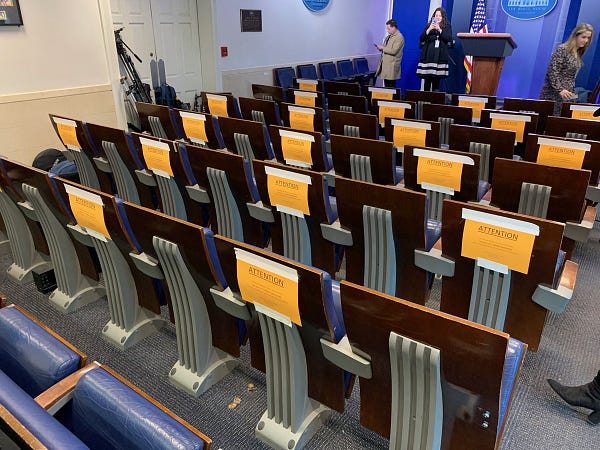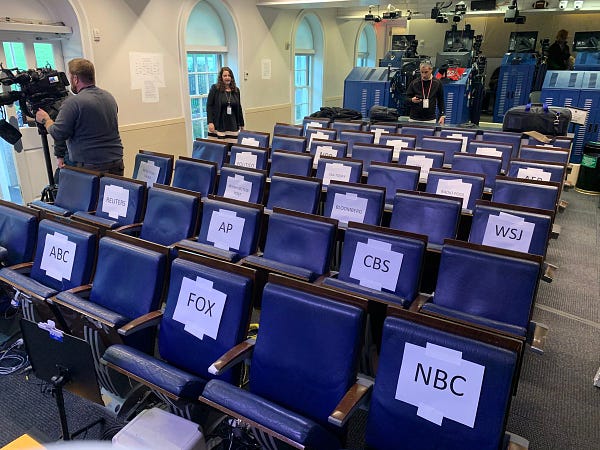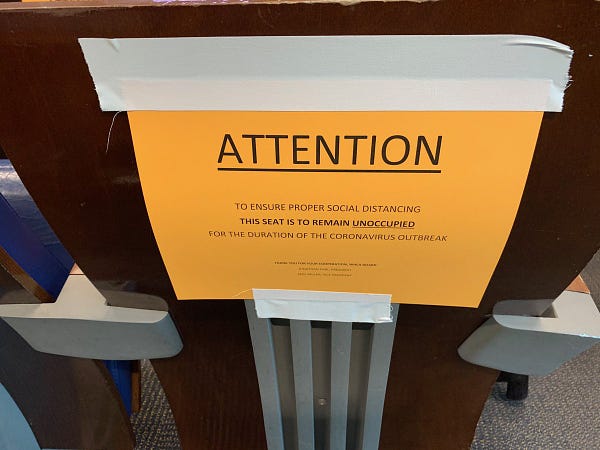I’m Scott Nover. Welcome back to Pressing, a newsletter about press freedom. If you haven’t yet subscribed, you can do so here and receive this letter in your inbox every Tuesday morning as well as special features for paid subscribers.
This is the 35th issue of Pressing and it’s great to have you with me. Please send me feedback, thoughts, suggestions, and tips at sgnover@gmail.com.
Well, This Looks Bleak
I’m safe. I’m home. I’m with my parents, and working out of my childhood bedroom. I didn’t plan for this. I didn’t think we’d get to this point. We got to this point. Things are pretty bleak.
Note #1: If you’re reading this—beyond all else—please know that it’s vital that you self-isolate and practice social distancing. Wash your hands with soap and water. Sanitize surfaces before you come in contact with them. The more you can restrict your movement, the safer everyone will be. The quicker we act the quicker we can save lives and control this pandemic.
Note #2: Most of you are working hard at your jobs as this crisis rages on. At the same time you might be balancing family responsibilities, stressing about finances and worried about friends and relatives. Remember to take care of yourself and your own physical and mental health.
This is especially true for journalists, who report tough news—about isolation and sickness and death. Please take care of yourself and reach out if you need anything.
Do you love Pressing and want to support it? Do you want to read a little more every week? If you are able and interested, please consider a paid subscription here!
Okay, life is insane and I haven’t stopped working, but here is a round-up of all the ways the coronavirus outbreak has affected press freedom and the safety of journalists:
The White House sent a memo to the White House Correspondents Association, saying, "When possible, members of the press seeking information are encouraged to call or email press staff as opposed to physically entering the Lower or Upper Press Offices,” THR’s Jeremy Barr tweeted. Another new rule: “Members of the press who do not have a seat on the updated seating chart or who do not participate in the President’s In-House Pool will not be permitted access to the White House Complex.”
There were fewer journalists in the room Monday and they sat a little further apart, too.




Yesterday was National Freedom of Information Day and both CPJ and RCFP called for government transparency during the coronavirus outbreak.
Poynter’s Al Tompkins and Sidney Tompkins wrote about 9 ways journalists can fight stress from covering the coronavirus.
CPJ has an incredibly comprehensive safety toolkit for reporters covering the coronavirus—in eight languages! AIR Media also has guidelines.
CPJ’s Ahmed Zidan published a Q&A with Lotus Ruan, a researcher at Citizen Lab about Chinese social media censorship around Covid-19.
Six employees at CBS News have tested positive for Covid-19, including foreign correspondent Seth Doane. At least one employee at NBC News has as well.
Wired’s Noam Cohen reports on how Wikipedia is tracking, writing about and fact-checking the outbreak.
Coronavirus closed our newsroom but has not slowed the journalists, Audrey Cooper writes in the San Francisco Chronicle. Similarly, The New York Times reported on “the newsroom at the center of the pandemic,” a.k.a. The Seattle Times.
Many news outlets are providing coronavirus coverage for free, taking down paywalls for vital information, as my Adweek colleague Sara Jerde reports.
The New York Times’ Ben Smith writes that social media platforms have actually been pretty good and responsible during the outbreak.
In Adweek, I wrote about how Snapchat might be the most reliable social network during the coronavirus panic, just by the nature of the platform’s design.
I also reported that many of Silicon Valley’s largest firms — including Facebook, Google, LinkedIn, Microsoft, Reddit, Twitter, YouTube — all put their name to a joint statement vowing to work together to root out misinformation and fraud on their platforms in response to the coronavirus outbreak. Earlier this month, I reported on the platforms’ struggles with misinformation.
The New York Times’ Javier C. Hernández reports on the Chinese government’s propaganda around its own coronavirus response.
And now for non-coronavirus news…
RCFP Releases Local News Findings
The RCFP released its findings from the 45 proposals it received for its Local Legal Initiative. Here are its top takeaways:
Facing dwindling revenues and shrinking staff, local newsrooms are struggling, and legal resources for affirmative access work are often the first to be cut.
Reporters are increasingly confronting a culture of secrecy in local and state governments that shields data, documents, and other public records, especially in the law enforcement context.
Journalists are frequently shut out of public meetings and court proceedings, making it difficult for them to report on government entities and the judicial system.
Members of the news media, government, and the public need training and education about the public’s right to access information.
Some journalists and newsrooms reported that they would feel more confident pursuing investigative reporting if they had access to an attorney to review sensitive stories before they are published and provide defensive support when reporters are served with subpoenas or threatened with lawsuits.
Elsewhere in the News:
The Intercept: TikTok Told Moderators to Suppress Posts by “Ugly” People and the Poor to Attract New Users
Business Insider: Activists created a 12.5 million block digital library in 'Minecraft' to bypass censorship laws
The Guardian: UK should be more innovative in defending press freedom, says Amal Clooney
Voice of America: Pakistan Arrests Media Owner on Graft Charges
Thanks for reading Pressing today and always. Like what you read and want to support me? Consider a paid membership here. Otherwise, I’ll see you next Tuesday! Send tips and feedback to sgnover@gmail.com.

